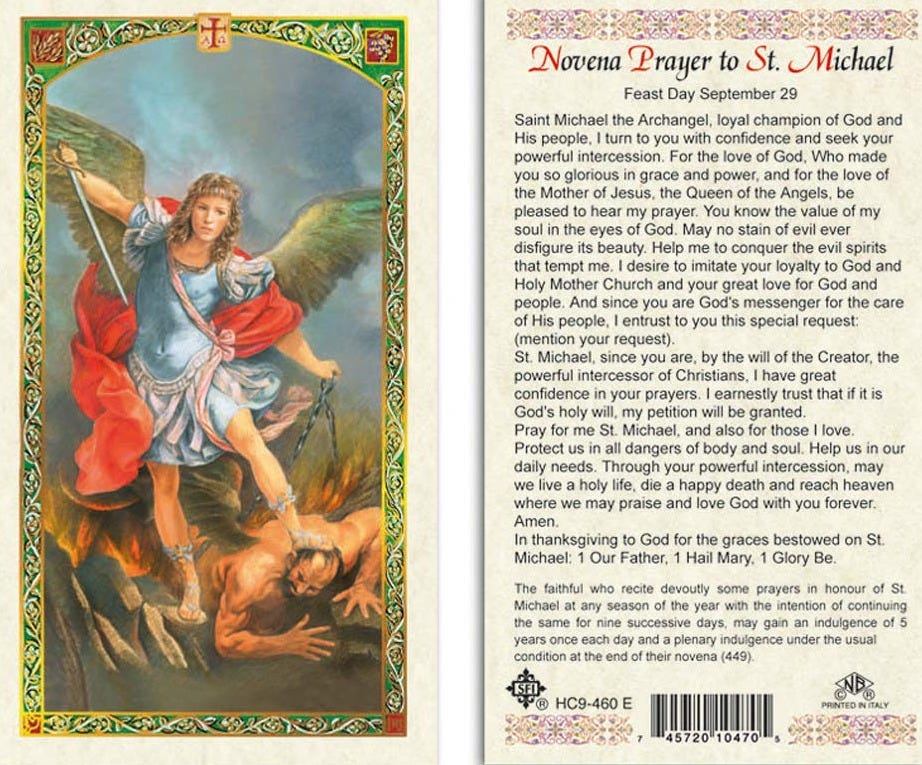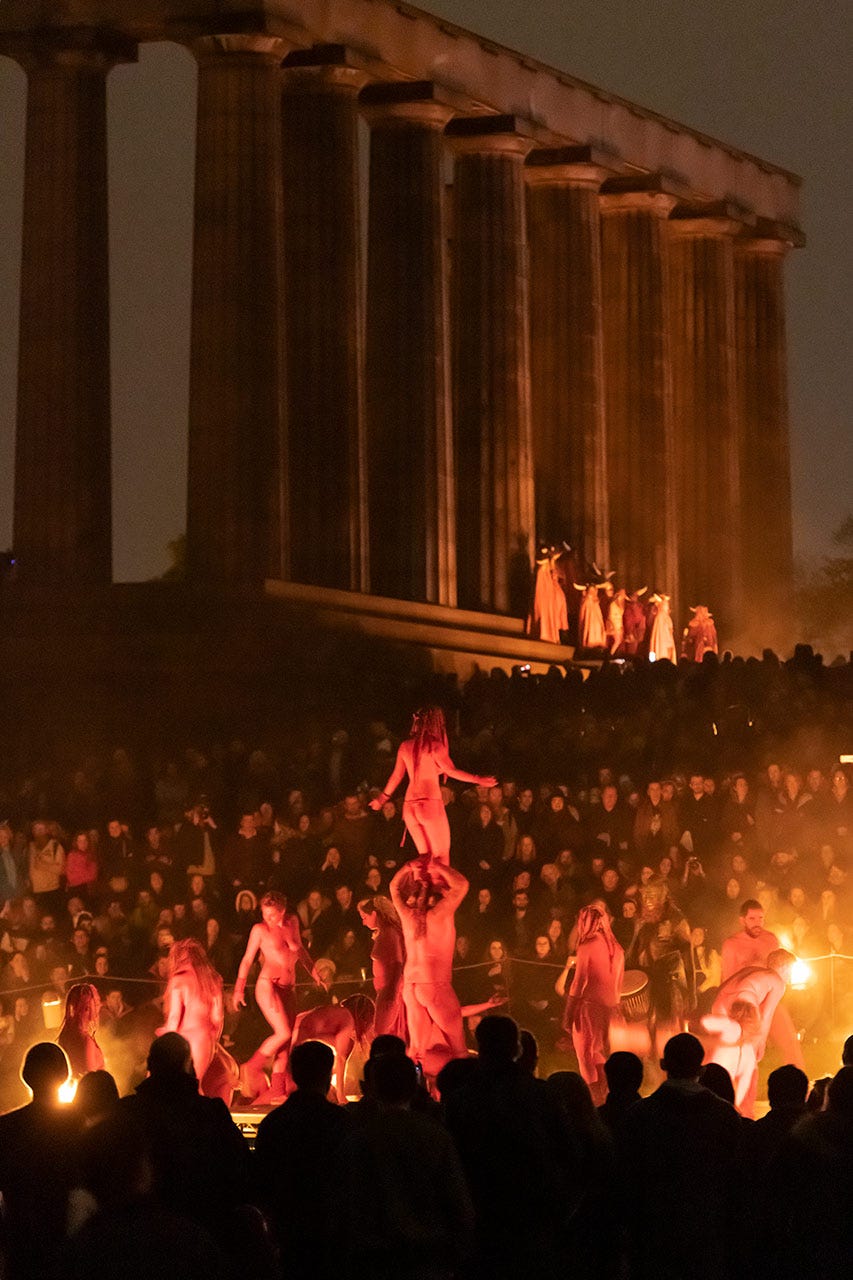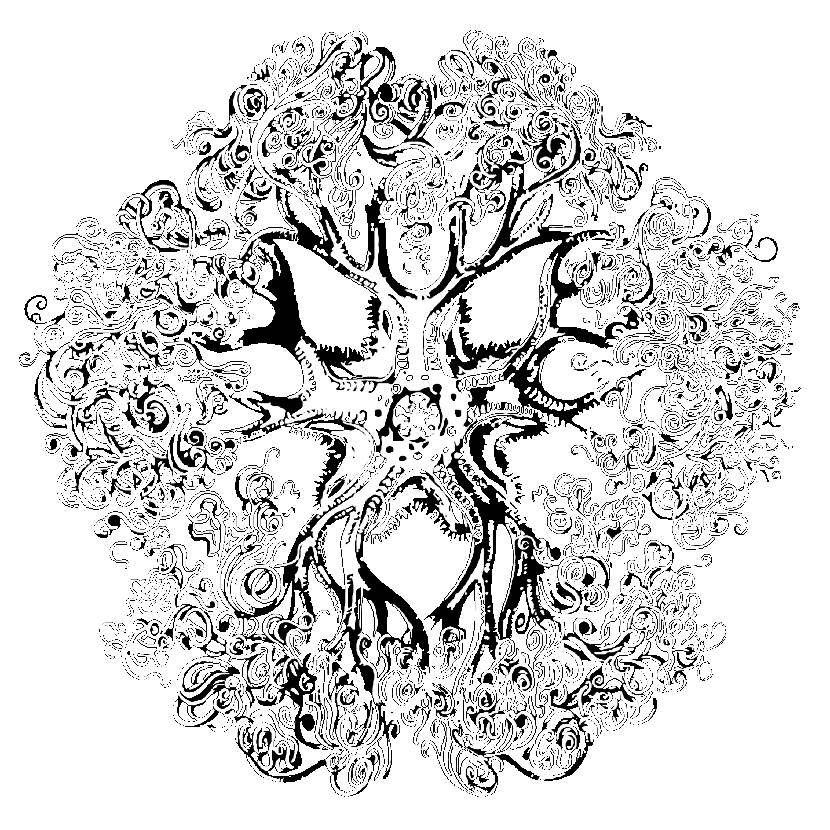The following article was originally posted on another site on April 24th 2023. Given its positive reception, I have revised and expanded it for this site. Future articles will further explore this theme of paganism and the cults of medieval saints.
Oftentimes, the Christian reaction to the ongoing revival of pagan religiosity can be summarized as pure bewilderment. Its reasoning is confusing, its premise unknown, and its intentions assumed. For that reason, the differences between them—and indeed they are often vast—are the most discussed. For a moment, I would like to discuss a similarity between the two, in hopes that this could assist onlookers in understanding some of the intentions and theology of both historical and revived paganism.
Many are aware of often tongue-in-cheek arguments that begin something like, “Didn’t you know XYZ is actually pagan?”, although probably not very robust ones. I initially wrote this to attempt such a robust argument on the topic, but decided the opportunity is better suited to explain to Christians a view of the pagan religious system of worship through something they are familiar with: saints. Though much of the historical particulars of the cults of saints and martyrs are uniquely Christian, the sum of the concept of sainthood itself cannot be properly understood without an analysis of Europe’s pagan past. Whether the similarities are meaningful or merely incidental is not necessarily my concern, however they can in the meantime assist in bridging a gap of understanding between these two religious systems.
Most illuminating to this point is the concept of patronage - an assigned corpus of acts and attributes to which the saint is noted for, and apparently given oversight over. Prayers and requests related to these things should be directed to their relevant patron who, as an intermediary between Earth and God, deliver a sought outcome. For example, the Christian tradition boasts many patron saints of medicine and healing: Damian, Luke, Brigid, and Padre Pio. Christians direct their prayers to these saints when they or their loved ones are ill and request their intercession, in hopes that their bodies will heal. This local parish has a handy list of dozens of healing saints, each with a specific illness they have been charged with the power to heal. There are saints of war and conquest, who's powers and likeness are requested before battle: George, Michael, or even Jeanne D'Arc. Novenas are practiced in a 9-day devotion to specific saints, seeking to gain their favor through supplementary religious devotion. These prayers and practices are performed not necessarily for salvation and forgiveness, but for the purpose of intercession with God to have a specific worldly need addressed.

This practice of worship, whether it is taken as a genuine profession of orthopraxic devotion or as evidence of demonic possession, is remarkably similar to the operation of paganism. We too focus our hearts and minds on a specific supernatural power—be it angelic or a since-risen man—in hopes to curate a relationship that can be called upon in times of need. The worshipper, seeking something of his own—be it wisdom, victory, or health—performs a ritual or prayer in veneration to this god. Often times, this occurs on important dates or anniversaries related to the god. The point of this practice, as it is for Christians and their saints, is to imitate and take on the likeness of a supernatural force for their own ends. A mother may internalize the grace and warmth of Mary or Freyja in hopes to model her own motherhood after theirs, and a man-at-arms may envision the marital ferocity of George or Apollo sweeping aside the forces of evil as he kneels before battle. This imitation, or perhaps even possession, is the sought end. A documented example of this practice can be found in theurgy, best known in the writings of the Neoplatonist Iamblichus.
Another Neoplatonist, Sallust, deals with this framework directly in his treatise On the Gods and the World, specifically in the section titled Why We Honor the Gods, Who are Not Indigent of Any Thing:
“But the honours which we pay to the gods, are performed for the sake of our advantage: and since the providence of the gods is every where extended, a certain habitude, or fitness, is all that is requisite in order to receive their beneficent communications. But all habitude is produced through imitation and similitude; and hence temples imitate the heavens, but altars the earth; statues resemble life, and on this account they are similar to animals; and prayers imitate that which is intellectual; but characters, superior ineffable powers; herbs and stones resemble matter; and animals which are sacrificed, the irrational life of our souls.”
Ibid., Ch. XV
Imitation and likeness is central to pagan worship, and this becomes more clear with a proper understanding of what a god actually is. A god may be briefly and simply described as a region of being, or a regional essence per Husserl; a transcendent, universal structure of reality as it appears to consciousness. Dyeus IS the regional essence of the sky, Taranis IS the region of being we hail at the sight of thunder. When we associate Dyeus and Sky, we are identifying a single thing, rather than a being and another thing which it possesses. For the patron saints on the other hand, these are men who are later assigned regions of being after death as something to oversee for the function of intercession and tradition. But the system of worship remains fundamentally identical.
Pagan Phenomenology I: What is a god?
This is part 1 of a 3-part series on my view of a pagan religious system heavily influenced by the works of Collin Cleary, Husserl, Heidegger, and others. Part 1 will describe phenomenology and how it can apply to paganism. Part 2 will set up a hierarchy of being and transition into Heidegger's contributions to ontology. Part 3 will suggest practical ad…
We wish to attain oneness with them, and by extension the universal principle which we may call Nature, Brahman, the One, or God - and we employ a ritualistic or contemplative practice to do so. For pagans, imitation is participation.
There are of course subtle differences that require mentioning. In contemporary practice, Christian practitioners toe a careful line between the concepts of intercession and worship. Indeed, this line has long been a source of contention between the various denominations of Christendom. Augustine, as a student of Neoplatonists and keenly aware of the correlation between paganism and saintly cults of his time, wrote extensively to remind fellow Christians of such and to keep their eyes on God. Yet, he knew it was not possible or desirable to abolish the cults themselves entirely. His compromise was a differentiation between two types of worship: latria and douleia. Latria is genuine worship, submission—to this belongs to God alone, while douleia is more of an honoring, a customary adoration. Perhaps it could be translated back into pagan terms: latria belongs to the gods, while douleia belongs to one's ancestors or heroes. As a note, it therefore cannot be said that Christians are, at least per canonical teaching, genuinely worshipping saints in a true sense of the word, and nor do they intend to.
I would however argue that the Christian relationship to saints underwent a significant transformation as it became increasingly inculturated by pagan peoples throughout the medieval. The defining cult of Early Christendom was that of martyrs, not necessarily saints, with saints typically serving as perhaps at most spiritual guardians or embodiments of a particular shrine. Only into the early medieval do we see the cults of saints fully developed, with an active and common practice of depending on saints as divine guarantors of worldly needs. We see saints increasingly allotted feast days and holidays, holy sites for pilgrimage, written prayers and novenas for intercession, and iconography rooted in cultural heritage. Often, these are directly lifted from a god and exhumed onto a saint, most clear in the case of Brigid and Saint Brigid. Beatification and canonization, of course, are concepts which extend no earlier than the medieval. There is therefore sufficient evidence to suggest that this phenomenon is of European origin. Historian John Wallace-Hadrill formalized this hypothesis in regards to medieval attitudes towards war:
“Why, then, did the men who converted the Anglo-Saxons differ so sharply from Wulfila? The Anglo-Saxons were not less bellicose than the Goths. The answer may lie in the prudent spirit of accommodation shown by Gregory the Great. More than that, the pope was an ardent supporter of warfare to spread Christianity and convert the heathen, and this last is, I think, the more important consideration. So far from rejecting the Germanic war-ethos the pope means to harness it to his own ends, and the evidence is that he succeeded. The barbarians may fight to their heart's content in causes blessed by the Church, and this is made clear not only in the matter of vocabulary. It is the position of the Church rather than of the Germans that had undergone modification. As Erdmann showed, the Church subsumed and did not reject the warlike moral qualities of its converts. Who shall say that St. Michael of later days was not Woden under fresh colours?”
- War and Peace in the Earlier Middle Ages: The Prothero Lecture, J. M. Wallace-Hadrill (1975)
For me, this is in keeping with the most obvious explanation. European religiosity, paganism, was successfully blended into and incorporated within the Nicene Creed, just as it was intended to be by the missionaries of Rome. The end result was medieval Christianity. To this day, European peoples continue these practices as what we've always understood as how best to interact with the divine. Even as Christians, this is how our people understood it. There are elements of paganism which actively breathe within European Christianity, because we are still dealing with religion as it appears to a European consciousness. Noting this is where my conversion began, and it may assist onlookers in understanding a system as bewildering as such.








This is a great article
Here are my quick thoughts as a Christian because nobody else really engaged on this
> the sum of the concept of sainthood itself cannot be properly understood without an analysis of Europe’s pagan past.
I would say it starts for Christians in the Old Testament, I know where this is going tho
>Most illuminating to this point is the concept of patronage - an assigned corpus of acts and attributes to which the saint is noted for, and apparently given oversight over. Prayers and requests related to these things should be directed to their relevant patron who, as an intermediary between Earth and God, deliver a sought outcome.
One way the Christian "system" is different is that you're not always attempting to appease someone in exchange for something else. For example, St. Anthony (patron of lost items) might be invoked to discuss how you feel about the item, prayer to remove desire for the item, really anything other than "use your magic powers to give me this item back". Afaik, there isn't a parallel to this in the pre-Christian traditions. It seems to me that encounters with pagan patrons was very transactional.
>seeking to gain their favor through supplementary religious devotion.
Maybe for Catholics I guess, but for the Orthodox the emphasis is on developing a personal relationship that models one's relationship with God. I tell my patron saint about my day, about how I'm feeling, I "talk" to him without necessarily wanting something. Again, this sounds very transactional i.e. more like the pagans.
>as evidence of demonic possession
Erm
>is remarkably similar to the operation of paganism
I don't agree with this
>in hopes to curate a relationship that can be called upon in times of need.
I watched the STJ Iceland documentary where he called upon Thor on top of the hill. Did he do that because he *loves* Thor? Or because he neutrally observed that Thor's domain exists on this hill in the way one might observe some other scientific fact? Christians *love* their patron saints. It's not about sending them your Santa wishlist because you sacrificed the appropriate time or resources to attain their power. In fact, that is basically simony.
>But the honours which we pay to the gods, are performed for the sake of our advantage
I won't keep repeating this, but I am not going to bite on Christian relationships with patrons being transactional in this way. You can't reduce a loving relationship to a formula invoked selfishly
>In contemporary practice, Christian practitioners toe a careful line between the concepts of intercession and worship.
Who? How?
> Indeed, this line has long been a source of contention between the various denominations of Christendom
When? There was the iconoclasm, but this was roundly defeated at the Council of Constantinople in 843. Nobody had a problem with it until the later incarnations of Protestantism.
>His [Augustine] compromise was a differentiation between two types of worship: latria and douleia
Yes, but it was St. Jerome that first described the different forms of veneration in the 340s. Obviously, Augustine (and later Aquinas) built out the concepts for the Western church, but I mention this to attack the idea that Augustine felt the need to improvise based on reports from the ministry to the Gauls or something. There was an already existing tradition, even earlier than Jerome depending on your Mariology.
>Only into the early medieval do we see the cults of saints fully developed
I don't think this is true, there were devotees to the original Apostles in the first century. "Cult" is the operative word here and I think it can only be applied to the martyrs, at least until later reforms from church leaders like Paul that toned it down.
>We see saints increasingly allotted feast days and holidays, holy sites for pilgrimage, written prayers and novenas for intercession, and iconography rooted in cultural heritage.
In Orthodoxy, this is more about celebrating their memory than the above transactional language. The idea is the living memory of the church forgets nothing.
>Beatification and canonization, of course, are concepts which extend no earlier than the medieval.
I don't think this is true
>There is therefore sufficient evidence to suggest that this phenomenon is of European origin.
In the Old Testament, we see the prophets being sanctified-- particularly the "major" prophets.
>European religiosity, paganism, was successfully blended into and incorporated within the Nicene Creed
I don't agree with this at all and I think the language of the Creed itself is the defeater.
"I believe"
Already a huge departure from European spirituality. Which pagans needed to consciously verbalize that they believed in Wotan? Is being pagan about accepting principles and adopting a new creed, or about being who you already are in the context of your ancestors? This declaration seems to be quite foreign to European spirituality.
>"And in one Lord Jesus Christ, the only-begotten Son of God, begotten of the Father before all ages; Light of Light, true God of true God, begotten, not created, of one essence with the Father through Whom all things were made"
This is an extremely dense passage of theology, alone quite unpagan, with several fundamentally irreconcilable statements and assumptions built in. Which pagan oral tradition records the energies/essence differentiation of Wotan's presence? Did they possess the vocabulary to articulate what it means to be begotten and not made? Which part of this was adopted from pre-Christian traditions?
>"Who for us men and for our salvation came down from heaven and was incarnate of the Holy Spirit"
The above applies, but there is no soteriology in paganism afaik. Again, a radical departure
>"He was crucified for us under Pontius Pilate, and suffered and was buried; And He rose on the third day, according to the Scriptures. "
This affirms the textual tradition and revelatory nature of Christianity, another major difference.
>"And in the Holy Spirit, the Lord, the Creator of life, Who proceeds from the Father, Who together with the Father and the Son is worshipped and glorified, Who spoke through the prophets."
Redoot of everything I already said up there
In other words, where is the secret paganism?
>The end result was medieval Christianity
*Western* medieval Christianity
We're swiss cheesing anyone who mentions the filioque.